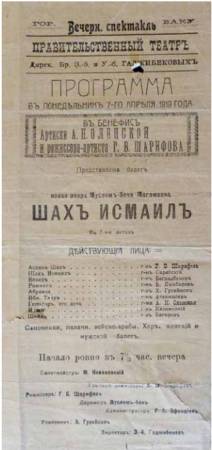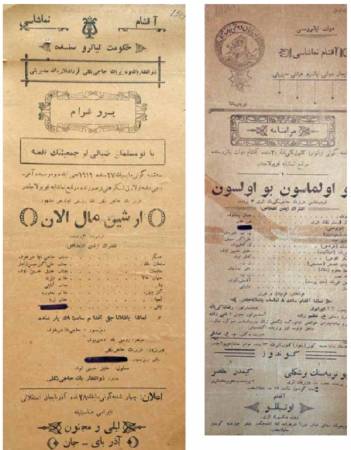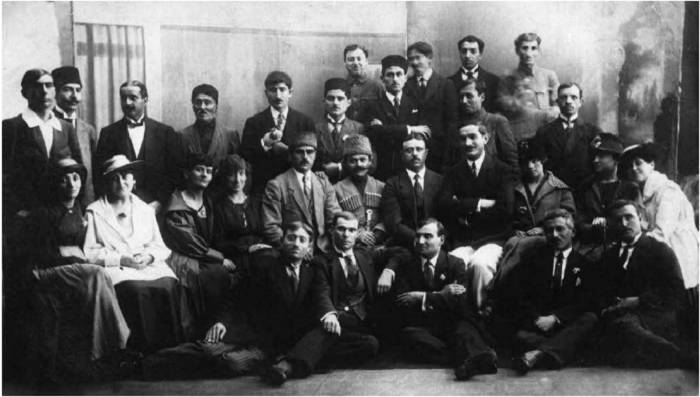The emergence of musical theater dates back to the beginning of the 20th century when the foundations of Azerbaijani professional music were laid. On 12 January 1908, the premiere of Uzeyir Hajibayov’s opera “Leyli and Majnun” was held in Baku, paving the way for the development of opera art in Azerbaijan. However, an amateur group led by young playwright A. Akhverdov had staged a scene called “Majnun on the Tomb of Leyli” from Fuzuli’s poem in Shusha in 1897-98 and a musical scene based on the poem of Alisher Navoi “Farhad and Shirin” was staged in Baku in 1902. These two events are considered to have started the history of Azerbaijani opera. As noted by U. Hajibayov, this is when the idea of creating an opera appeared in his mind.
The premiere of “Leyli and Majnun” marked the start of the history of the first musical theater in the entire Muslim East. The creative path of the Azerbaijani musical theater turned out to be thorny. The founders of Azerbaijani opera art U. Hajibayov, Z. Hajibayov, H. Arablinsky, G. Sarabsky, M. Magomaev, M. Aliyev and many others, who ushered a new type of art for their people, were inspired by the confidence in the great progressive significance of the initiated cause, great love and support of the people.

Seal of the Azerbaijan State Theater. 1919, NMHA
Over the years, the theater’s repertoire was replenished with new musical works by U. Hajibayov and Z. Hajibayov. In 1910, U. Hajibayov composed the first operetta “Husband and Wife”, which initiated the development of a new genre of musical comedy in Azerbaijan. In the same year, the composer wrote his second operetta, “If not that one, then this one”. Both works were staged in Baku and were a huge success. However, the most remarkable musical comedy which became one of the pearls of Uzeyir Hajibayov’s career was “Arshin Mal Alan”, the premiere of which was held in Baku in October 1913. It was subsequently staged with great success in many cities around the world and has not lost its artistic value to this very day.
A theater troupe called a “Directorate of the Z. and U.Hajibayov brothers” was set up in Baku in 1916. It staged both dramatic and musical performances. The first performance the troupe staged at the theater of the Mayilov brothers was the opera by Zulfugar Hajibayov “Ashug-Garib” which featured H. Sarabsky and A. Agdamsky. The director of the play was Abbas Mirza Sharifzadeh. As “Caspian” newspaper wrote, the production was a great success: “The Mayilov theater had not seen so many people under its arches for a long time”.
The political chaos followed by the tragic events of March 1918 had a serious impact on the cultural life of the city. The work of theaters and acting troupes stopped. Only after Baku was liberated by the Caucasian Islamic Army and the capital of the ADR government moved to the city in September 1918 was it possible to revive theatrical work in the country. The first to resume work was the troupe of the Hajibayov brothers. As before, it staged dramatic, comedy and opera performances and operettas with the participation of renowned actors of the time H. Sarabsky, A. Agdamsky, M. Aliyev, J. Bagdadbayov, H.Huseynov, A. Sharifzadeh, H. Hajibababayov, G. B. Sharifov, A. and E. Olenskys, Lizina and others. The performances were run three to four times a week.
In order to promote further development of theatrical art in the country, the government passed a resolution on 19 October 1918 to transfer theaters to the Ministry of Education.

Program for the premiere of the “Shah Ismayil” opera by composer Muslim Magomayev. Baku, 1919. NMHA
On 18 October 1918, a significant event occurred in the theatrical life of Azerbaijan – the Azerbaijan State Theater was established and the theater building of the Mayilov brothers was transferred to it. It was the first state theater in the country, and leading directors and actors started to rally around it. On 22 August 1919, in order to develop the national theater, train actors and raise their professional level, a joint meeting of the board of the Baku “Union of Turkic actors” and the board of the “Directorate of the Hajibayov brothers” decided to open artistic courses on four directions: drama, comedy, music and literature. Zulfugar and Uzeyir Hajibayovs, Muslim Magomayev and Gurban Primov were appointed as directors of the music department.
On 17 November 1919, a government meeting heard the of the Minister of Education on the organization of the Turkic opera and drama theater, and approved the establishment of the State Turkic Theater of Opera and Drama.
A series of events culminated in the creation of a state theater and its subsequent nationalization. The development of theatrical art began to be viewed as a matter of national importance.

Programs of Uzeyir Hajibayli’s operetta “Arshin Mal Alan” and “If not that one, then this one” produced in 1919. NMHA
Many valuable exhibits reflecting the theatrical life of Baku during the ADR period are stored at the Azerbaijan National History Museum. The photographs, posters and other exhibits demonstrated in the new exposition of the museum detail the history of the musical theater. Of particular note is the seal of the Azerbaijan State Theater from 1918 with a depiction of a lyre, the emblem of a crescent with a star and an Arabic inscription in the Azerbaijani language saying “Presidium of the Azerbaijan State Theater”. The seal comes from the collection of outstanding Azerbaijani actor Sidgi Ruhulla Akhundov.

Troupe of the Azerbaijan State Theater. 1919. In the center are Uzeyir Hajibayli (director of the troupe, 2nd row, fifth from right) and Muslim Magomayev (2nd row, fourth from right)
The premiere of M. Magomayev’s opera “Shah Ismail” was also held in the ADR years. It was an important event in the cultural life of the country. The author had completed the score of the opera in 1916, but the premiere took place only on 7 March 1919. The opera
was a great success, as evidenced by reviews in the local media pointing to its rich melodic language. The young composer’s success was greatly facilitated by the fact that the part of Shah Ismail was performed by outstanding actor Huseyngulu Sarabsky. In fact, the premiere was conducted on the actor’s benefit night.
Also available at the museum is a poster on the staging of the opera on 8 March 1919 and the program of “Shah Ismail” at the government theater on 7 April 1919. The directorate of the “Z. and U. Hajibayov brothers” staged the performance on the benefit night of actress A. Olenskaya (who performed female roles in Azerbaijani performances) and the director and actor G. Sharifov.

Playbill of M. Magomayev’s opera “Shah Ismayil”. Baku, 1919. NMHA
A major role in the development of Azerbaijani musical theater was played by visiting representatives of Russian and European theaters and performers of classical West European and Russian opera. This is confirmed by a poster of the State Theater regarding the production on 9 April 1919 of lyric opera “Mignon” by French composer Charles Thom based on Goethe’s novel “Wilhelm Meister’s
Apprenticeship” (actors Boronkin and Berezin, conductor B. A. Hess), opera “La Boheme” by G. Puccini on 10 April and “The Tsar’s Bride” by N. A. Rimsky-Korsakov on 12 April.
The birth and development of Azerbaijani musical theater is closely connected with the names of great composers U. Hajibayov, M. Magomayev, Z. Hajibayov, prominent actors H. Sarabsky, A. Agdamsky, M. Aliyev, G. Arablinsky and others. A photo placed in the exposition shows a company of the Hajibayov brothers’ theater which subsequently formed the core of the professional musical theater. Their outstanding talent and dedication to theater made an enormous contribution to the development of Azerbaijani musical culture.

Playbill of the premiere of the opera “Mignon” by composer Ambroise Thom. Baku, 1919. NMHA
IRS Heritage
More about: Azerbaijan Theatre
















































